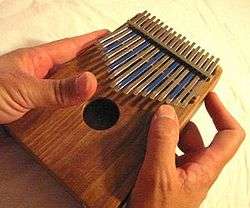Hugh Tracey

Hugh Tracey (1903–1977) was an important twentieth century ethnomusicologist. He and his wife collected and archived music from Southern and Central Africa. He began making field recordings of music in the early 1920s, through the 1970s.
Early work
Hugh Tracey arrived in South Africa in the 1920s and immediately became fascinated with the local culture. He was particularly interested in the Mbira,[1] an instrument found nowhere else in the world. In his efforts to spread awareness of the Africa’s vast musical heritage, he created an adaptation of the Mbira known as the Kalimba.
The Kalimba, which literally translates as “little music”, was designed so that it could be learned and appreciated internationally. Hugh created the Kalimba so that its melodies and harmonies would be more suited for the western tradition of music. Made from an African hardwood, with notes made out of European spring steel, the Kalimba is known for its tranquil and enchanting sounds.
Today, Kalimbas continue to be handcrafted in a family run workshop in Grahamstown, South Africa. They come in several different models: the treble and celeste treble (17 notes, 2+ octaves), the alto and TM alto (15 notes, 2 octaves), 11 note pentatonic kalimba, the African-tuned karimba, and an 8-note beginner's kalimba.
International Library of African Music
Tracey founded the International Library of African Music (ILAM) in 1954, and became its director. ILAM publishes the African Music Society Journal. Hugh's sons, Andrew and Paul, also became well known ethnomusicologists and musicians specializing in African music. Andrew took over ILAM as director following his father's death. Paul and his wife Barbara composed several songs for the Muppet Show. Their son, Devon, is a web designer, social commentator, and video maker.
Field Recording Tours
Tracey embarked on a number of recording tours throughout Africa. Notable tours include:
- 1957 - Zambezi Valley (Valley Tonga tribe) recording tour[2]
- 1958 - Nyasaland recording tour[3]
- 1958 - Swaziland recording tour[4]
- 1959 - Western Transvaal and Bechuanaland recording tour[5]
- 1959 - Basutoland recording tour[6]
Recordings
- Musical instruments 2: (LP) Reeds (Mbira). (1972) The Music of Africa series. 1 LP disc. 33 1⁄3 rpm. mono. 12 in. Recorded by Hugh Tracey. Kaleidophone, KMA 2.
- 21 CDs recorded by Tracey were produced by ILAM- see the link for further information.
Selected publications
- The Evolution of African Music and its Function in the Present Day, Johannesburg: Institute for the Study of Man in Africa, 1961a
- "The Mbira class of African Instruments in Rhodesia (1932)". African Music Society Journal. 4 (3): 78–95. 1969.
- Chopi musicians: their music, poetry, and instruments. London: Oxford University Press. 1970 [1948].[lower-alpha 1]
- African music research: transcription library of gramophone records : handbook for librarians. Gallo (Africa). 1961.
- "Towards an Assessment of African Scales". African Music. International Library of African Music. 2 (1): 15–20. 1958. JSTOR 30249468. (subscription required (help)).
- "A Case for the Name Mbira". African Music. International Library of African Music. 2 (4): 17–25. 1961b. JSTOR 30249527. (subscription required (help)).
- "The state of folk music in Bantu Africa". African Music: Journal of the International Library of African Music. 1 (1): 8–11. 1954. ISSN 0065-4019.
- "The future of music in Basutoland". African Music: Journal of the International Library of African Music. 2 (2): 10–14. 1954. ISSN 0065-4019.
- "The International Library of African Music". African Music: Journal of the International Library of African Music. 1 (1): 71–73. 1954. ISSN 0065-4019.
- "Recording African music in the field". African Music: Journal of the International Library of African Music. 1 (2): 8–11. 1955. ISSN 0065-4019.
See also
Notes
- ↑ Describes the Timbila of Mozambique
- ↑ Tracey 1961b.
- ↑ Tracey, Hugh (1957). "Recording in the lost valley". African Music: Journal of the International Library of African Music. 1 (4): 45-47. Retrieved 7 May 2016.
- ↑ Tracey, Hugh (1958). "Report on the I.L.A.M. Nyasaland recording tour (May 7th to June, 1958)". African Music: Journal of the International Library of African Music. 2 (1): 65-68. Retrieved 7 May 2016.
- ↑ Tracey, Hugh (1958). "I.L.A.M. recording in Swaziland (May 24th to April 3rd)". African Music: Journal of the International Library of African Music. 2 (1): 64. Retrieved 7 May 2016.
- ↑ Tracey, Hugh (1959). "Recording tour of the Tswana tribe: Western Transvaal and Bechuanaland Protectorate, October - November, 1959". African Music: Journal of the International Library of African Music. 2 (2): 62-68. Retrieved 7 May 2016.
- ↑ Tracey, Hugh (1959). "Basutoland recording tour, November 19th to December 3rd, 1959". African Music: Journal of the International Library of African Music. 2 (2): 69-76. Retrieved 7 May 2016.
References
- Jones, A. M. (1971). Africa and Indonesia the Evidence of the Xylophone and Other Musical and Cultural Factores. Brill Archive.
- Post, Jennifer (2013). Ethnomusicology: A Research and Information Guide. Taylor & Francis. ISBN 978-1-136-70518-2.
- Hudson, Mark (1999). "Hugh Tracey:Pioneer Archivist". In Simon Broughton, Mark Ellingham & Richard Trillo. World Music: Africa, Europe and the Middle East. Rough Guides. ISBN 978-1-85828-635-8.
- Levine, Laurie (2005). The Drumcafé's Traditional Music of South Africa. Jacana Media. ISBN 978-1-77009-046-0.
- Thram, Diane Janell (2010). For Future Generations: Hugh Tracey and the International Library of African Music. International Library of African Music. ISBN 978-1-920355-96-8.
- "Hugh Traceys Portrait". International Library of African Music. Rhodes University.
External links
- African Musical Instruments
- ILAM International Library of African Music
- Review of Tracey's work in ethnomusicology
- Kalimba Magic's interview with Andrew Tracey, which includes information about Hugh Tracey.